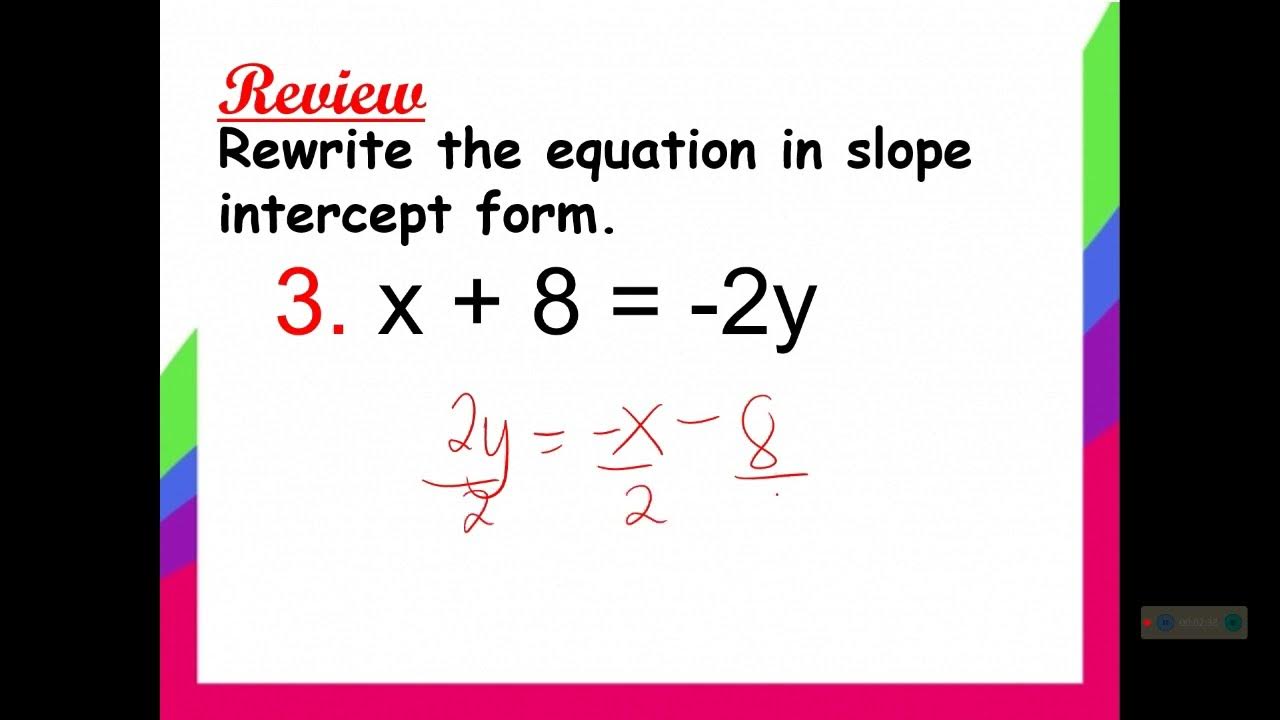Linear Equations - The Intercept Form - Algebra
Summary
TLDRThis video explains how to find the X and Y intercepts of linear equations using the intercept form. The tutorial covers the different forms of linear equations, including slope-intercept, standard, and point-slope forms, with a focus on the intercept form. It demonstrates how to convert equations to intercept form and how to easily identify the X and Y intercepts. Examples are provided to clarify the process, with step-by-step guidance on solving for the intercepts by manipulating the equation. Viewers also learn how to handle special cases where coefficients are not easily reducible.
Takeaways
- 😀 The script covers four key forms of linear equations: slope-intercept, standard, point-slope, and intercept form.
- 😀 The intercept form of a linear equation helps easily determine the X and Y intercepts.
- 😀 To find the X intercept in intercept form, set Y = 0 and solve for X.
- 😀 To find the Y intercept in intercept form, set X = 0 and solve for Y.
- 😀 The intercept form equation is written as X/a + Y/b = 1, where a and b are the X and Y intercepts, respectively.
- 😀 Converting an equation to intercept form can simplify the process of finding intercepts.
- 😀 The script demonstrates how to convert standard form equations to intercept form using division.
- 😀 Example 1: In the equation 3X + 4Y = 12, the X intercept is 4 and the Y intercept is 3.
- 😀 Example 2: In the equation 4X + 5Y = 20, the X intercept is 5 and the Y intercept is 4.
- 😀 Example 3: In the equation 7X - 8Y = 56, after conversion, the X intercept is 8 and the Y intercept is -7.
- 😀 Example 4: In the equation 4X - 7Y = 9, the X intercept is 9/4 and the Y intercept is 9/7, with a more complex conversion process.
Q & A
What are the four forms of a linear equation mentioned in the video?
-The four forms of a linear equation mentioned are: Slope-Intercept Form (y = mx + b), Standard Form (ax + by = c), Point-Slope Form (y - y1 = m(x - x1)), and Intercept Form (x/a + y/b = 1).
How do you find the X-intercept of a linear equation using the intercept form?
-To find the X-intercept, set y = 0 and solve for x. The result gives the point where the line crosses the X-axis.
How do you find the Y-intercept of a linear equation using the intercept form?
-To find the Y-intercept, set x = 0 and solve for y. The result gives the point where the line crosses the Y-axis.
What does the intercept form of a linear equation look like?
-The intercept form of a linear equation is x/a + y/b = 1, where 'a' is the x-intercept and 'b' is the y-intercept.
How do you convert a linear equation from standard form to intercept form?
-To convert from standard form to intercept form, divide the entire equation by the constant term on the right-hand side of the equation.
What is the benefit of using the intercept form of a linear equation?
-The benefit of using the intercept form is that it allows you to easily identify the X and Y intercepts directly from the equation.
In the equation 3x + 4y = 12, what are the X and Y intercepts?
-For the equation 3x + 4y = 12, the X-intercept is 4 (ordered pair (4, 0)) and the Y-intercept is 3 (ordered pair (0, 3)).
How do you solve for the X and Y intercepts in the equation 4x + 5y = 20?
-In the equation 4x + 5y = 20, to find the X-intercept, set y = 0, resulting in x = 5 (ordered pair (5, 0)). To find the Y-intercept, set x = 0, resulting in y = 4 (ordered pair (0, 4)).
What is the significance of the signs in the intercept form of a linear equation, as demonstrated in the equation 7x - 8y = 56?
-The signs in the intercept form are important because they affect the direction of the intercepts. In the equation 7x - 8y = 56, the negative sign with the y-term is moved to the denominator of the y-intercept, making it negative (-7) when the Y-intercept is calculated.
In the equation 4x - 7y = 9, how are the values of 'a' and 'b' in the intercept form calculated?
-In the equation 4x - 7y = 9, 'a' is calculated as 9/4 (after dividing both sides by 9), and 'b' is calculated as 9/7. The intercepts are therefore x = 9/4 (ordered pair (9/4, 0)) and y = 9/7 (ordered pair (0, 9/7)).
Outlines

このセクションは有料ユーザー限定です。 アクセスするには、アップグレードをお願いします。
今すぐアップグレードMindmap

このセクションは有料ユーザー限定です。 アクセスするには、アップグレードをお願いします。
今すぐアップグレードKeywords

このセクションは有料ユーザー限定です。 アクセスするには、アップグレードをお願いします。
今すぐアップグレードHighlights

このセクションは有料ユーザー限定です。 アクセスするには、アップグレードをお願いします。
今すぐアップグレードTranscripts

このセクションは有料ユーザー限定です。 アクセスするには、アップグレードをお願いします。
今すぐアップグレード関連動画をさらに表示

How To Find The X and Y Intercepts of a Line

Introduction to intercepts | Algebra I | Khan Academy

FINDING THE EQUATION OF A LINE GIVEN THE X AND Y - INTERCEPTS || GRADE 8 MATHEMATICS Q1

Linear Functions

Graph & illustrates Linear Function Find the Domain Range Table of values Intercepts & Slope Math 8

Graph of Linear Equations Using Slope Intercept (Part 1)
5.0 / 5 (0 votes)
